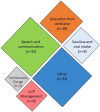Management of tracheostomies in the intensive care unit: a scoping review
- PMID: 32723731
- PMCID: PMC7390235
- DOI: 10.1136/bmjresp-2020-000651
Management of tracheostomies in the intensive care unit: a scoping review
Abstract
Objectives: While there is an extensive body of literature surrounding the decision to insert, and methods for inserting, a tracheostomy, the optimal management of tracheostomies within the intensive care unit (ICU) from after insertion until ICU discharge is not well understood. The objective was to identify and map the key concepts relating to, and identify research priorities for, postinsertion management of adult patients with tracheostomies in the ICU.
Design: Scoping review of the literature.
Data sources: PubMed, Embase and Cumulative Index to Nursing and Allied Health Literature were searched from inception to 3 October 2019. Additional sources were searched for published and unpublished literature.
Eligibility criteria: We included studies of any methodology that addressed the a priori key questions relating to tracheostomy management in the ICU. No restrictions were placed on language or year of publication.
Data extraction and synthesis: Titles and abstracts were screened by two reviewers. Studies that met inclusion criteria were reviewed in full by two reviewers, with discrepancies resolved by a third. Data were extracted for included studies, and results mapped along the prespecified research questions.
Results: 6132 articles were screened, and 102 articles were included for detailed analysis. Protocolised weaning was found to be successful in liberating patients from the ventilator in several cohort studies. Observational studies showed that strategies that use T-pieces and high-flow oxygen delivery improve weaning success. Several lines of evidence, including one clinical trial, support early cuff deflation as a safe and effective strategy as it results in a reduced time to wean, shorter ICU stays and fewer complications. Early tracheostomy downsizing and/or switching to cuffless tubes was found to be of benefit in one study. A substantial body of evidence supports the use of speaking valves to facilitate communication. While this does not influence time to wean or incidence of complications, it is associated with a major benefit in patient satisfaction and experience. Use of care bundles and multidisciplinary team approaches have been associated with reduced complications and improved outcomes in several observational studies.
Conclusions: The limited body of evidence supports use of weaning protocols, early cuff deflation, use of speaking valves and multidisciplinary approaches. Clinical trials examining post-tracheostomy management strategies in ICUs are a priority.
Keywords: not applicable.
© Author(s) (or their employer(s)) 2020. Re-use permitted under CC BY-NC. No commercial re-use. See rights and permissions. Published by BMJ.
Conflict of interest statement
Competing interests: None declared.
Figures



References
-
- Klotz R, Probst P, Deininger M, et al. . Percutaneous versus surgical strategy for tracheostomy: a systematic review and meta-analysis of perioperative and postoperative complications. Langenbecks Arch Surg 2018;403:137–49. - PubMed
-
- Perkins MP, King C, Moores LK. Early versus late tracheostomy: a metaanalysis. Chest 2009;136:16S 10.1378/chest.136.4_MeetingAbstracts.16S-h - DOI
Publication types
MeSH terms
LinkOut - more resources
Full Text Sources
Miscellaneous
